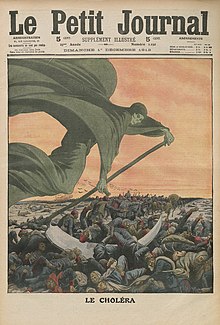Pandemia de cólera de 1899–1923
A sexta pandemia de cólera (1899–1923) foi um grande surto de cólera, que começou na Índia, onde matou mais de 800.000 pessoas, e se espalhou pelo Oriente Médio, norte da África, leste da Europa e Rússia.[1]

É considerada uma das principais pandemias da história.[2]
História editar
De acordo com Leonard Rogers, após um surto de cólera em Haridwar Kumbh Mela, a epidemia se espalhou pela Europa por Punjab, Afeganistão, Pérsia e sul da Rússia.[3][4]
O último surto de cólera foi nos Estados Unidos em 1910–1911, quando o navio a vapor Moltke trouxe de Nápoles pessoas infectadas para Nova York. As autoridades de vigilância sanitária isolaram os infectados na ilha de Swinburne, construída no século XIX como uma instalação de quarentena. Onze pessoas morreram, incluindo um profissional de saúde no hospital da ilha.[5][6][7]
A pandemia atingiu o Império Otomano e Norte da África em 1910.[8]
Referências
- ↑ «Cholera's seven pandemics». Canadian Broadcasting Corporation.
At the turn of the century, the sixth pandemic killed more than 800,000 in India before moving into the Middle East, northern Africa, Russia and parts of Europe. By 1923, cholera had receded from most of the world, although many cases were still present in India.
- ↑ «Recalling history's 10 deadliest diseases that came before the coronavirus». The Economic Times. 1 de março de 2020
- ↑ R. Dasgupta. «Time Trends of Cholera in India : An Overview» (PDF). INFLIBNET
- ↑ Rogers, L. (1926). The Conditions Influencing the Incidence and Spread of Cholera in India. Proceedings of the Royal Society of Medicine, 19(Sect Epidemiol State Med), 59–93.
- ↑ The Boston Medical and Surgical Journal. Massachusetts Medical Society. [S.l.: s.n.] 1911.
In New York, up to July 22, there were eleven deaths from cholera, one of the victims being an employee at the hospital on Swinburne Island, who had been discharged. The tenth was a lad, seventeen years of age, who had been a steerage passenger on the steamship, Moltke. The plan has been adopted of taking cultures from the intestinal tracts of all persons held under observation at Quarantine, and in this way it was discovered that five of the 500 passengers of the Moltke and Perugia, although in excellent health at the time, were harboring cholera microbes.
- ↑ «Cholera Kills Boy. All Other Suspected Cases Now in Quarantine and Show No Alarming Symptoms.» (PDF). New York Times.
The sixth death from cholera since the arrival in this port from Naples of the steamship Moltke, thirteen days ago, occurred yesterday at Swinburne Island. The victim was Francesco Farando, 14 years old.
- ↑ «More Cholera in Port». Washington Post.
A case of cholera developed today in the steerage of the Hamburg-American liner Moltke, which has been detained at quarantine as a possible cholera carrier since Monday last. Dr. A.H. Doty, health officer of the port, reported the case tonight with the additional information that another cholera patient from the Moltke is under treatment at Swinburne Island.
- ↑ Unat, E. K. (1995). «[Cholera epidemics in the Ottoman Empire during 1910-1913 and relevant events]». Yeni Tip Tarihi Arastirmalari = The New History of Medicine Studies. 1: 55–65. ISSN 1300-669X. PMID 11625085
Leitura adicional editar
- Hays, J.N. (2005). Epidemics and Pandemics: Their Impacts on Human History. ABC-CLIO. [S.l.: s.n.] ISBN 9781851096589
- Azizi. «History of Cholera Outbreaks in Iran during the 19th and 20th Centuries» (PDF). Middle East Journal of Digestive Diseases. 2: 51–55. ISSN 2008-5230. PMC 4154910 . PMID 25197514